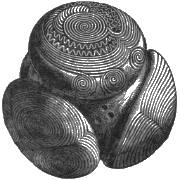Canmore Site 21609: COLL, TRAIGH FEALL - COLL - HUMAN REMAINS (PERIOD UNKNOWN), MIDDEN(S) (PERIOD UNKNOWN), SETTLEMENT (PERIOD UNKNOWN), PIN (BRONZE), UNIDENTIFIED FLINT(S) (FLINT), UNIDENTIFIED POTTERY
Description
| Site Name | COLL, TRAIGH FEALL |
|---|---|
| Other Name(s) | CROSSAPOL BAY |
| Site Number | NM15SW 7 |
| Broad Class | AGRICULTURE AND SUBSISTENCE, RELIGIOUS RITUAL AND FUNERARY, UNASSIGNED (OBJECT), DOMESTIC |
| Site Type(s) | HUMAN REMAINS (PERIOD UNKNOWN), MIDDEN(S) (PERIOD UNKNOWN), SETTLEMENT (PERIOD UNKNOWN), PIN (BRONZE), UNIDENTIFIED FLINT(S) (FLINT), UNIDENTIFIED POTTERY |
| NGR | NM 14 53 |
| NGR accuracy | NGR given to the nearest 1km |
| Local Authority | ARGYLL AND BUTE |
| Parish | COLL |
| Record created | 1988-03-28 |
| Last updated | 2000-10-03 |
Archaeology Notes
NM15SW 7 14 53.
A storm on the 28th December 1879 exposed a settlement, kitchen middens, and human remains at the bottom of a large deep sand-valley, 1/2 mile from Coll Castle. The valley, which looks out to the Atlantic on the NW, is c.1/4 mile long by 200 yds broad below, and much more at the top. Over a period, nearly 100' of perpendicular sand has been removed from the valley. At its bottom, nearly at sea level, and within 1/4 mile of it, over a 1/4 mile in area, was a cluster of oval or sub-circular stone walls. One structure was 23 yds in longest diameter, and the rest were rather smaller. Near each group of dwellings were massive shell-mounds, containing flint fragments, animal bones and pottery fragments. A penannular brooch, dateable to the 9-12th c. AD, and an earlier Celtic ring-headed pin from this site were exhibited to the Fellows of the Society by John Stewart of Coll, who visited the site with Ross (D Ross 1881 and 1882). Simpson (D D A Simpson and M Simpson 1968), discussing the pin, now lost, suggests that it may have been an import from Ireland.
Ross (D Ross 1881 and 1882) suggests that this area, now under sand, was once a boggy marsh, and these remains found represent lake-dwellings, of which there are a large number in Coll, including one discovered a few years ago, with a bronze sword hilt near it, on the margin of this sand area (NM15SE 2).
D Ross 1881 and 1882; D D A Simpson and M Simpson 1968; Proc Soc Antiq Scot 1881.
Beveridge (E Beveridge 1903) states that there are numerous settlement sites occupying the isthmus between Traigh Foill and Crossapol Bay, most distinct towards the S, especially a large circle 12 yds in diameter on a mound of sand, covered with loose stones, some of considerable size with many flints - some scrapers, worked bones, pottery fragments, polishing stones; also a shell-midden, containing bones, and a bone needle.
A little NE were more flints, pottery, and a few pieces of iron, near another kitchen-midden with bones, and marks of fire. Near this spot was found a bone needle, two stone sinkers and a greenish stone axe.
N of this site are the remains of a long, rectangular stone wall, or more probably causeway, Beveridge also suggesting a lake-village here, though not of crannog type, the dwellings connected by causeways, the whole covering most of the S half of the isthmus. The causeway runs N from one heap of stones to another, then N again, afterwards turning W. Beveridge (E Beveridge 1903) adds that the penannular brooch, in the possession of Col Stewart, was found at Cliad, and not Traigh Foill as described by Ross. (D Ross 1881 and 1882)
Finds from this area, which were in Beveridge's collection, were donated to the National Museum of Antiquities of Scotland (NMAS) in 1907 and 1922. They comprised: HD 332-3 - two pottery fragments, HD 335 and HD 337 - bone pins, HD 341 - bone needle, HD 342 - curved piece of bone, and AB 1482-5 - four small flint thumb scrapers.
E Beveridge 1903; Proc Soc Antiq Scot 1922.
Site not definitely located but probably in the area centred NM 147 539 which roughly agrees with Ross's description.
A hut circle (NM15SW 15) may be part of one of Beveridge's numerous settlement sites (E Beveridge 1903), but nothing else was seen in this extensive area of shifting sand dunes. Nothing known locally of Col Stewart's collection.
Visited by OS (I S S) 23 June 1972.
Further articles from here are in Glasgow Art Gallery and Museum (Acc No: '55-96) and the NMAS (AB 1469-76). HD 332 is classified as a rim sherd of a large vessel, possibly a cinerary urn, while HD 333 is a rim sherd of a food vessel.
RCAHMS 1980; J Close-Brooks and J N G Ritchie 1980.
Identifiers and Links to Other Records
This record has no links! Would you like to help?
| Identifier / External Link | Linked Record | Status | Comment |
|---|---|---|---|
| Canmore Site Number (legacy): NM15SW 7 | No linked record |
This area is visible only to logged in users.
